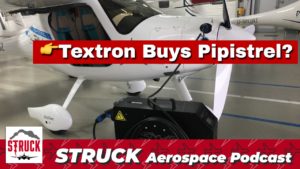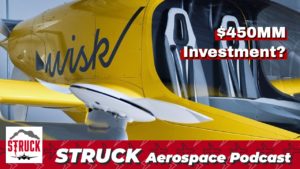The Boeing 737 MAX has an extending wheel system – how does it work? The Northrup Grumman Model 437 autonomous aircraft is impressive, but when will we see it in action? And, the Biden Administration is handing out half a billion dollars to aerospace companies and airlines – is it just a bandaid? Great video on the Boeing 737’s Wheels here.
Learn more about Weather Guard StrikeTape segmented lightning diverters and aircraft lightning protection consulting services. Follow the show on YouTube, Twitter, Linkedin and visit us on the web. Have a question we can answer on the show? Email us!
Podcast: Play in new window | Download
this episode is brought to you by Weather Guard lightning tech at weatherguard we support design engineers and make lightning protection easy you’re listening to the struck podcast i’m Dan Blewett i’m Allen hall and here on struck we talk about everything aviation aerospace engineering and lightning protection
Transcript: Northrup Grumman Model 437 & Boeing 737 Max 10 Wheel Engineering
Alright welcome back to the struck aerospace engineering podcast i’m your co-host dan blewett on today’s episode a lot of policy news coming out of the u.s so the biden administration has put a bunch of awards out there are there’s clean air and cleaner fuel there’s a big push for improving some of that efficiency and reducing carbon emissions you know getting sustainable airline fuel developed all these sort of things so the byte administration is pushing a lot of money out to the faa and other agencies to end to some large aerospace companies themselves to help to develop some of these technologies so we’ll talk through a bunch of the implications there uh in our engineering segment we’re going to talk about northrop grumman’s new uh model of an autonomous aircraft that’s got some serious speed um possibly used for future drone missions uh the boeing 737 max’s extending wheels which are really unique and interesting and we’ll talk a little bit about a 2 megawatt electric motor from right so let’s start allen with the faa so biden has you know the administration has earmarked some money to the faa and as part of their clean program they’re doling a lot of this out to general electric aviation honeywell pratt whitney boeing roar delta techops gk and aerospace mds coding and america’s phoenix they’re all working on different projects to meet some of these standards for co2 emissions you know hoping to reduce that to by about 20 percent uh nox uh emissions by 70 and noise as well also particular particulate matter so give me some of your perspective on this obviously you know reducing emissions is difficult um and you’ve talked a bunch at length in the past about how maybe the airlines should be not quite in the same boat as you know transport other other forms of transportation yeah so the by the administration essentially handing out checks to some larger aerospace companies is kind of unique uh and they can do it under the veil of a lot of different uh projects at the moment and the obvious one for them is uh clean air right so they i think this is sort of indicative of a larger problem that’s going on that the airline industry in general has been has been in a financial hurt and they’ve been asking congress for some relief for at least a year maybe a little bit longer now and they’re starting to get in the in different forms uh so there’s been several hundred million dollars over a half a billion dollars doled out so far and i think more is yet to come now you know you kind of wonder if ge and honeywell weren’t already on some of these tasks uh particularly ge you know gets been pushing cleaner skies for a long time and and they’ve been doing a lot of work internally forever so this is not unusual for them but i think it’s just a a a unique way of trying to get funding to these companies and i i think the bigger scope is at what point will the abide administration start to realize that they need to get the airline industry going and pumping cash into it isn’t a long-term fix it’s a short-term bandage don’t you see that dan like we got to get people flying again and it seems like for some policy reasons we we’re avoiding and in fact i think it was again this week where dr fauci was talking about restricting people’s access to travel on airlines and trains and buses and everything else if they didn’t have a vaccine card which is just makes friction right friction reduces travel yeah and i mean that’s that’s true yeah i i guess i’m not sure how all the the pieces fit together because some of this money is going to you know like you said these aerospace companies who are developing technologies for the future obviously that’s good for his agenda because hey we’re doing thing we’re active right trying to fight against carbon emissions for climate change um so for that you know liberal base who’s you know really concerned about that of course there’s obviously moderates and conservatives who care about the environment as well um you know that seems like an important part of it now 100 million dollars to those bunch of companies doesn’t seem like that much money um especially considering you know engineers are well paid and and hard to find people um so i don’t know i don’t know how far that money goes on on the one hand of course there’s a lot of different layers to this so they’re also um besides the aerospace companies they’re giving 482 million in pandemic relief to the greater you know aviation industry so some of the airliners trying to keep jobs and trying to keep those companies from cutting jobs and then of course there’s all these other standards that he’s implementing you know they’re trying to get to a greenhouse gas emissions decline of 20 percent by the end of the decade so um trying to get that down by 2030. um i mean do you feel like that’s a realistic goal that i mean 20 cut seems pretty big at this point especially considering like you said how hard aviation’s companies are trying to reduce fuel consumption anyway right you know another even another 10 i think is going to be difficult at this point just because of the advances the industry has made over the last 30 40 years there’s not a lot of uh extra room to screen out squeeze out efficiencies you’re you’re kind of there right feels like kind of like the olympics like sprinters are so fast now they’re not gonna you know they’re not gonna jump from 9.7 to 9.4 like the human capacity is getting pretty close right um is it kind of the same way on aircraft or not not so much that’s a really good point do you remember a couple years ago the discussion and the research done about jesse owens and saying if you had put jesse owens in today’s footwear and on today’s athletic tracks that he’d be running just as fast as like a usain bolt like they’d be really close he would be competitive in that arrangement even though that was 1936 or somewhere in there where he competed right so uh it sort of has the same feel to it like yeah we have this existing technologies there’s only so much you can squeeze out of it so you’re just basically changing the the track shoes so to speak that the core of it is still pretty much the same there’s only some so many things you can do there yeah he was incredible he i mean he like obliterated people back then like he was so much faster than the other the common man of his day but yeah and of course usain bolt is a great example because he seems like the perfect specimen of a human being to run as fast i mean long levers credibly explosive i mean like he’s built to sprint as much as any humans ever been um and so like improving on usain bolt seems really hard right i mean like he’s fastest human in the world it’s like how do you get better than that right um because training is pretty modernized i mean there’s you know there’s a lot it seems like there’s a lot of parallels between the two worlds but i mean are any of these fuels going to make that big of a difference i mean i don’t know the we’ve talked a little bit about some of the sustainable fuels but um are they really going to be able to put the performance in the same category or and you’ve talked about safety like you don’t want to just like throw some new fuel through a system because in a car you know if the ethanol mix or something for example doesn’t work the car rolls to a stop right but planes can’t can’t glide down to a stop obviously right well i think it comes down to energy density and the fuels right and some of the sustainable fuels have less energy density means we got to carry more of them which seems overall that become can become less efficient so is it really worth the development extra cost for something that’s less efficient you just stick with what you have right now and try to make it more efficient that’s that’s a really good question because i think with the advent of the electric motor you know at what point did we just say all right we’ve we’ve honed the jet a fuel market as best as we’re ever going to get it or really close to it maybe we can squeak out another 2-3 let’s just say that and then do we then whatever aircraft we can transition over to electric we transition it to to overall the whole industry is a mission profile that may be the way that it’s accomplished but i don’t like the way that this is going in the in the sense of it’s like an edict from on high and engineers are just supposed to salute to this uh bureaucracy that’s creating an emissions standard out of whole cloth that doesn’t feel right and as you can see as a result of that the aircraft industry as a whole is really suffering and has not been able to get off its feet and it needs to because there’s a lot of it’s almost like the automotive industry there are a lot of jobs signed up at up in aviation right now yeah yeah and of course um you know the reporting from the ap news explains that only 2.4 million gallons we talked about this in the past as well only 2.4 million gallons of sustainable aviation fuel were consumed or were produced as of 2019 and that’s in comparison to the airlines burning 21.5 billion gallons so 2.4 million into 21.5 billion is 0.01 percent of the supply so to get that up to the point where it’s you know significantly higher seems like a really big step in like you said that nine year period because who’s going to build the infrastructure and the and the plants to produce that amount of fuel and like you said is it going to be up to par and like you said is it going to be more economical in the grand scheme because you start thinking of carbon the total carbon cost of and that was like like we’ve discussed that was part of the problem with ethanol was like people like well okay so we’re using corn this from corn but we’re also having to truck this and do more like we have to process more there’s like there’s so many more things involved where it didn’t seem and i don’t know that what’s ultimately happened with ethanol but it seems like it never it just like sort of quietly lost favor and i know i know it’s still used in the midwest but you don’t see it very much yeah right right yeah and i think this is i think i feel like it’s really complicated because i didn’t know a lot of this and and i think when you start to think of the emissions that apply you just think that okay well a mission standard should blankly apply well if blanket leaves a word but i’m using it as a word it should apply in a blanket state stay in a blanket manner to all forms of transportation like why should aircraft get a pass over trains or cars you know etc but to your point being an engineer who knows the the industry you know very intimately there’s just a lot more context to that like you said like they’ve been trying to reduce submissions forever because it’s good for business and that’s probably the best push to any of them is like hey this is good for business we want this just as much as anyone else does and then just say hey well you have to do this like like the cars do that’s just like where i feel like people they miss the miss the greater point and like you said the energy density thing is a really interesting not public you know the public are not privy to that they don’t understand quite that yeah you might have to burn 20 more fuel to get the same output and is that is that better yeah it’s it’s really complicated which i i i wonder if they dive into that enough trying to explain like this is why we’re doing this when they’re trying to push some of this legislation even if it’s just suggested sort of targets right i think the aviation community itself sort of knows these things but where as we see it on our renewable energy podcast when we talk about things like energy density and the overall cost of energy creation uh on the aviation side that never gets discussed discussed in public which is weird so i think we’re going to get to that point eventually get to that point when push comes to shove and and the administration the bureaucracy starts to push the the aviation aerospace industry is really going to push back and say hey look this is not going to be a long-term solution maybe a temporary solution but it’s not going to be a long-term solution well let’s talk a little bit more about the the funding that’s been earmarked for um aviation aircraft companies so it’s not just like commercial airliners but for example the largest recipient of some of this government funding is speared error systems which makes fuselages and other parts for boeing their big supplier and they’re in kansas uh you know your hometown so they’re going to get 75 and a half million which the government says will protect 3 000 plus jobs um so is that a good move or is this like you said a myopic move i mean what do you think this is gonna what’s what do you think the long-term and short-term implications will be yeah that there’s a there’s just an announcement out today talking about this uh there’s about a hundred million dollars going to the state of kansas and different uh aerospace associated affiliated companies uh 75 million is going to spirit aerosystems which is in wichita another 15 million is going to learjet so there’s there’s 90 million out of the 100 the remaining 10 kind of gets dispersed around to different smaller aviation related businesses the the emphasis there is on jobs and retaining jobs so i think there’s around 4 000 5 000 jobs or say they’re going to be able to keep employed which is a big deal right 5 000 jobs essentially in wichita kansas is a big deal i guess the question is how long is this going to go on how much longer can we sort of tie this over which is pouring cash into these companies because either boeing is going to get up to production and spirit’s going to be making money or or they’re not allergic it’s in a little bit of a different mode because they essentially shut down all aircraft aircraft production uh the last layer jet i think comes out in the next couple of weeks i think so they’re they’re in a little bit of a different struggle but all the the the smaller aviation companies are relying upon the avian asian industry as a whole to be flying in and modifying and upgrading and doing all the things that happen there and it’s just not happening at the rate that they need it to so it feels like sort of an inside job a little bit kansas has a very strong delegation when it comes to aviation and pushing the faa or the commerce department to kick out funding towards their particular their state if you look at the way that it’s described in some of the articles it says the the commerce department is the commerce department um reached out to the companies that could be helped by this funding and made sure that they applied so you see this sort of like this little inside chain like ah the phone’s ringing hey we’re going to give you 50 000 would you like it yeah we’re struggling sure we’ll sure we’ll take 50 grand right that’s the kind of thing that’s happened there and that just is plays into the larger frame of hey when are we going to get off our backsides and get life moving again and as of yet i haven’t seen good markers on that it seems like over the last week or so the the coveted response and the biden administration’s push to mandate vaccinations is not going to help that situation any uh particularly most these corporations that we’re talking about in kansas have over 100 employees yeah so that that’s going to be a fight well of course on the other side of it i mean i know employers are really struggling to get employees at this time right so you know uh was was it spirit that was struggling that had to start canceling flights i think a couple airlines had to cancel some flights or trim back because of staffing shortages and i think that’s some of the some of the fears behind unvaccinated employees where they don’t want to have another like they can’t afford any more losses so i so i get it from that end but you’re right anytime you make more friction um it’s gonna make it more difficult for people to travel and then bottleneck to some degree but it’s hard to say how much um yeah i mean and i guess we’ll we’ll see what covet holds in store for the winner um but a lot of the stuff we’re just not gonna know the results of until we kind of get through it unfortunately probably just a lot of hindsight will be the best that we’ll have but right yeah i agree yeah so those are but i mean are you optimistic by the amount of money that’s been doled out i mean what what’s your overall i mean considering all these different uh financial awards is this a was this a net positive or sort of neutral or you give it a thumbs down i think it’s at best a neutral at this point what you would like to see is uh the competitive nature of the aviation marketplace start to kick in again where spirit is competing with the gkn and you know all those big honeywell is competing with collins and you’re having those big colossal battles for market share we’re not having those at the moment we’re just like everybody’s just letting orders come in everybody’s stable we’re not trying to do too much we’re not trying to spend too much effort on any particular project and let’s let’s reduce our cash burn let’s not do much in terms of advertising let’s just kind of lay low for a while and that that has a similar feel to what i remember from the late 70s into parts of the 90s uh into the early to the 2000s again which is the nba industry knows how to to to conserve cash and to try to survive and it feels like we’re in that mode right now and they’ll stay there for a while and the the op the flip side of this which is uh not really thought about when this happens is those aviation companies aren’t really hiring gonna hire too many new engineers and so it creates this little lull in the employment base so you have these uh wide spans of engineering age groups and employee age groups in terms of line workers and that sort of thing where they’re in these discrete modes of there’s a group of people roughly the same age that were during the last upturn and then there’s a 10-year delay and there’s another group of people that are all hired at the same time so you don’t have this continuity and i think that in itself hurts aviation more than the economy does because it just you just have these really unique um internal uh machinations that happen because of the the span in engineering time and things aren’t handled down i don’t think things are handed down like they would be in a sort of continually growing increasing business cycle all right moving on we’ve got a couple things to talk about on the engineering side today first let’s start with northrop grumman they’ve unveiled art for their model 401 and model 437 aircraft which will be autonomous that they hope could be the air force’s next big generation of drones you know and accompany manned planes into battle this is that sort of hybrid human and ai potential you know force in the skies that seems like it makes a lot of sense so the model uh 437 will have a 3 000 mile range which is crazy um and it’s also going to be extremely fast i think getting as high as uh mach 0.85 um al what what features strike uh you know strike you here it looks a lot like any other almost supersonic jet that sort of really stealthy design a lot like the predator um but what sticks out to you here as far as the engineering well i think the range does and the ability to be stealthy which is automatic at this point no not even discussions about that it just is you can tell by the shape of the aircraft that it’s going to be has some stealthy features just by the shape alone and what when you take the human out of the aircraft you also rip out a number of aircraft systems that have to be there flight instrument displays an oxygen system pressurization system and just all the feedback stuff that a pilot requires you can just rip all that stuff out there by reducing the weight making the aircraft more aerodynamic and therefore increasing its range in times time in in service so that changes everything right if you can get the pallet out of the loop it’s not so much a reaction time thing as much as it is just an efficiency piece of of the aircraft performance and so north grumman’s been doing this since you know pre-global hawk right so global hawk is a massive aircraft it just is and they’ve flown that thing at 70 000 feet plus halfway around the world autonomously so they have the technology to do this i think what’s this is a really weird spot right now i think for the air force don’t you don’t you see this too damn like that like not having a pilot there feels weird and so they still want to have a pilot in control of the of the autonomous aircraft it’s a that’s a weird setup because she wouldn’t really need the pilot out there anymore you wouldn’t think are you talking about the pilot like an accompanying jet near it or are you talking about an actual pilot manning the controls back at the base well well they may need somebody on the ground i think that is still likely to occur the question is do you need somebody like in an f-35 out there and con you’re right do you need this person out there administering all this activity that you’re your other autonomous aircraft that are flying in formation behind you do you need do you need that f-35 out there i think right now the argument is yes but i’m not sure that’s going to last very long yeah because it i mean if this was like a helicopter strike or something for example there’s a lot more you can visually see like you can assess the situation um you know there’s a human element that could be involved um whereas at that height i mean you can’t imagine like what decision can a human make that’s not going to be based on radar or any other sort of instrumentation that it doesn’t really need an interpretation from the cockpit itself like you could interpret any of those pieces of you know instrumentation from a thousand thousand miles away in in your base so yeah i guess it is it is unclear because it’s not like he’s gonna be like come on guys no it’s fine they’re like no we need to pull back it’s you’re tens and tens of thousands of feet up in the air yeah i mean that the computer is going to do pretty much most of the seeing at that point i would i would assume right is there a top gun situation at all are we are we quote unquote dog fighting aircraft anymore i think the answer is no i think the the key right now is that we we uh defend ourselves and and attack from miles and miles away uh which you know we can you can argue about the the ethics of all that but that’s what’s happening right now so you’re not having those in quote unquote engagements where you’re shooting machine guns at one another that doesn’t happen uh maybe air to ground that’ll occur but air to air really hasn’t happened a long time so you know how many more pilots are we going to need in in flying f-35 is a really good question because it’s autonomy is happening so fast in the air and on on the ground in automobiles that you kind of wonder how much longer it’s going to be and even little tiny evital companies uh you know they’re not lockheeds right they’re not boeings these these small evita companies have been flying these electric aircraft autonomously for years at this point relatively safely so it just makes you wonder you know how long the pilot’s going to be in this thing yeah of course we’ve talked about darpa and their work and and their they’ve had these ai dog fight simulations where they’ve done well um when dog fighting against a real pilot in simulators but you’re right it seems like that day is is pretty far gone so we’ll have to keep keep an eye on this and see how it tends to evolve so another interesting piece of engineering is the boeing 737 max 10 uh their wheel system so the max 10 is 1.6 meters longer than the max 9 and apparently this little little boost in fuselage length is important because now it’s going to change the geometry of when the plane comes down to land and boeing was worried about potentially smacking the tail on the on the runway so the landing gear has a really interesting mechanism where it’ll actually extend to make the plane effectively stand taller to give it a little extra clearance ellen it seems like there’s a lot of like you said there’s a lot of engineering that even goes into the bathroom door latch what are some of the features in this incredibly important mechanism that helps these extend out um while being just as durable obviously like i think atlanta gears is incredible that you think of this huge heavy plane with such forces that these wheels and these little extensions can handle all that and never snap off because they can never snap off even one time and they don’t so take us through some of the engineering here well it’s interesting because the max 10 has gotten so long that on takeoff on some of those longer airplanes like the 757 some of this and the stretch dc-9s md md80s are so long on takeoff when they pull pull back on the stick that actually the tail can strike the runway you don’t want to do that in fact some airplanes have like skid plates back there and they have these tail strike sensors it looks like a little whisker off the back end it’s a biscuit switch that says hey you’ve hit the asphalt on the runway don’t do that and we need to look inspect the aircraft because you can you can bend a fuselage you hit the runway hard enough with the tail so what boeing has done is that they’ve essentially extended the length of the landing gear by about 10 inches but it’s a it’s like it expands and grows and i need to look at the mechanism a little bit more it seemed like on takeoff as the aircraft lifted off it would this extension would kind of pop out and help prevent the tail from striking the runway and but the problem is obviously is when you extend the landing gear you got to pull the landing or up into the fuselage somehow and they wanted to keep the same volume that the previous 737s in the same landing gear area and not have to change wing spars and all the structure so that the mechanism actually collapses that the knight or tenon just collapses back so the landing kit can still fit in the same hole in the wing so to speak that makes a lot of sense now it’s it’s funny that you know there’s when you think about the max 10 and some of these longer 737s you don’t think about stuff like that all the little engineering changes and i’ve seen some of the other max 10 changes and and some of the max changes and you wouldn’t think that boeing would hit some of these areas mostly it looks like some of them for weight savings and maybe some manufacturing savings like they’ve retouched a lot of the airplane that as a consumer still looks like a 737 you know still seems to fly like a 737 but there is a lot of engineering that goes into these these model uh improvements i’ll say and that you just don’t get to see so it is i think it is interesting that boeing actually created a little video for this and that’s helpful right i think as one of the things that boeing’s going to get killed on here recently is saying all the engineers aren’t doing the job properly well they need to they need to make some puff pieces that say hey yeah we’re doing some cool stuff and we are working really hard at it and it helps i think that kind of public operations message helps them because they they could use all the help they could get right now don’t you think so yeah i mean yeah if you’re only taking flack and you’re never getting any pats on the back your job becomes a grind for sure and they do do some pretty amazing work and yet like i said i don’t people there’s so many things on the on an airplane that we all take for granted and the landing gear is really like these tiny little wheels hold up this entire gigantic plane landing at hundreds of miles per hour um well i guess they’re probably one in the single like 150 what’s what’s what’s touchdown yeah speed 100 ish miles per hour run 100 miles an hour yeah yeah i mean it’s like such crazy force and this little mechanism keeps the whole thing from from from going down so yeah hats off to the boeing engineer is pretty pretty neat um and definitely check out the youtube video we’ll link to it in the description below so last on the docket today is right which is a startup w-r-i-g-h-t they say they have a a two megawatt electric uh engine that they’re hoping can really change and be a big part of the uh the switch to electric power and aircraft now they’re definitely going to start smaller they’ve said um they’re not trying to you know immediately power 737s and you know even that’s a small commercial airliner but this is a two megawatt motor that they say produces about 2700 horsepower equivalent and it’s the the most powerful motor designed by a factor of two of course it’s designed it’s not you know out there yet and they also say it’s going to be very very light so it’s in lab testing so it does exist um and they’re just working on testing alan how how does this design strike you and and where do we feel like the future of electric aviation stands here well the interesting thing about this right design and some other electric motor designs that are more recent is that they’re going roughly down the same pathway which are in a motor sense their permanent magnet motors and they’re trying to get the electronics to drive them as hard as they can now there’s some trade-offs here that have to be made in terms of the operating voltage you want to run the system at and how you can control that but the the key is here you’re dumping massive amounts of energy in a very small space like these motors if 2300 horsepower is what you said 23 2700 horsepower now think of what that would be in terms of an internal combustion engine that’s a big engine right that’s like something used on a on like two race cars jammed together it would be 20 that kind of that kind of horsepower but yet it’s probably the size it’s less than the size of one racing engine right it’s roughly that size so the energy density is really high and that means there’s a lot of heat that you have to bleed off of these engines so the the the issue is not so much that can you generate that kind of of thrust and horsepower the question is can you cool it fast enough that the thing doesn’t melt down that’s a bigger problem right now and there’s a lot of work on the thermodynamics of these motors making sure they have extreme amount of airflow through them making sure that they’re monitoring the temperature of the motors so that they don’t over basically cook themselves because you can’t do that on with some of these high power electric motors you can you can definitely do that so if you look at the right design it looks like a big thermodynamics problem they have a lot of metal surfaces a lot of cooling holes they must be forcing air into the motor they may have motors that actually cool the bigger motor just to try to drive air through it because what do you do on the ground and this is i think this is the bigger issue with these what do you do on the ground when you’re taxing around and you don’t have a lot of airflow through the motor like your flight can you cool can you cool it off what happens on takeoff do you over temp edges rolling down the runway and you’re at max thrust but you don’t have max air flow can you tolerate that kind of stuff so the the the kicker here is we’re going to see a lot of these height powered permanent magnet motors start popping out but the industry is going to help develop around it are the thermodynamics engineers that are going to be solving a lot of these airflow cooling problems liquid cooling it will be in play in a lot of these motors and air air flow uh will be in place so it’s it’s a lot of engineering challenges ahead well two things number one that makes me think of this time when i was coming back uh mostly across the country with a car that’s radiator was i didn’t know what was wrong with it but it was not working so if i was in a residential area going slow or stopped i just watched my temperature go up to the red line i was like so i had to stay at speed so when i was on the highway it could cool itself and but when i slowed down or i stopped or i was at a red light i was just like come on change come on change gotta change gotta change got a good green so i can cool this car off again um and then eventually got it replaced but um yeah so i feel your i feel your pain on the runway there um but number two i mean with the i mean the fact that they won’t have to carry so much fuel on board that weight savings i mean can they use that for like a really serious huge fish tank like air like water cooling system and you even you see some computers that have and lots of servers have water cooled not water cooled but liquid cooling um i mean is that something that can support this was like hey we saved x amount of pounds on fuel weight so we’re gonna we have a really insane cooling system um i mean is that the trade-off gonna happen or is that maybe a little too ambitious yeah no there’s a lot of trade-offs going on right now on particularly the larger electric aircraft designs which is you know how much horsepower can i generate how much cooling system can i tolerate in terms of the weight right and it’s going to be a liquid cooling system a lot of them and then how much how much energy can my batteries maximally deliver for this motor can i even drive it hard enough with the batteries that i have can i deliver enough current and do i need to be operating at a higher voltage to reduce the losses and cables and there’s a lot of weird uh engineering analysis that are going on that haven’t been done before because you’re right dan i mean the thing about batteries is you have this sort of fixed pack and the weight never changes versus fuel as you burn it off the aircraft gets lighter and that’s it advantageous so you actually get more efficient as you burn off fuel so you kind of after like half a flight or you cooked off half the batteries energy you got this dead weight right and you have to carry that day weight around so there the dynamics change a lot versus a traditional internal combustion engine or jet airframe what what do you do with this weight and how do you manage this weight and are the batter on the batteries carrying enough energy density the answer is always no right you always like to double the energy density if you could because they’re if you you you’re going to have a fixed amount of weight you can tolerate i think that’s what’s happening on the batteries and then everything else is sort of designed downhill from that but it’s going to lead to a lot of different aircraft designs and i think like i’m saying the thermodynamic designs are going to get really uh intricate they’re going to be little tiny design details they’re going to make these these electric motors work or not work and we’re going to see a lot of development in those areas so making electricity go down wires and turn motors it’s relatively simple cooling all that is complicated well i know we’re going to end today’s episode of the struck aerospace engineering podcast thanks so much for listening be sure to subscribe whether you listen on itunes spotify stitcher or if you watch us on youtube and if you have the moment please leave us a review of the show we greatly appreciate it as you know reviews always help drive new listeners and convince them to take a chance on our podcast thanks again and we’ll see you next week on struck strike tape weatherguard lightning tech’s proprietary lightning protection for radomes provides unmatched durability for years to come if you need help with your radon lightning protection reach out to us at weatherguardarrow.com that’s weatherguard dot com












